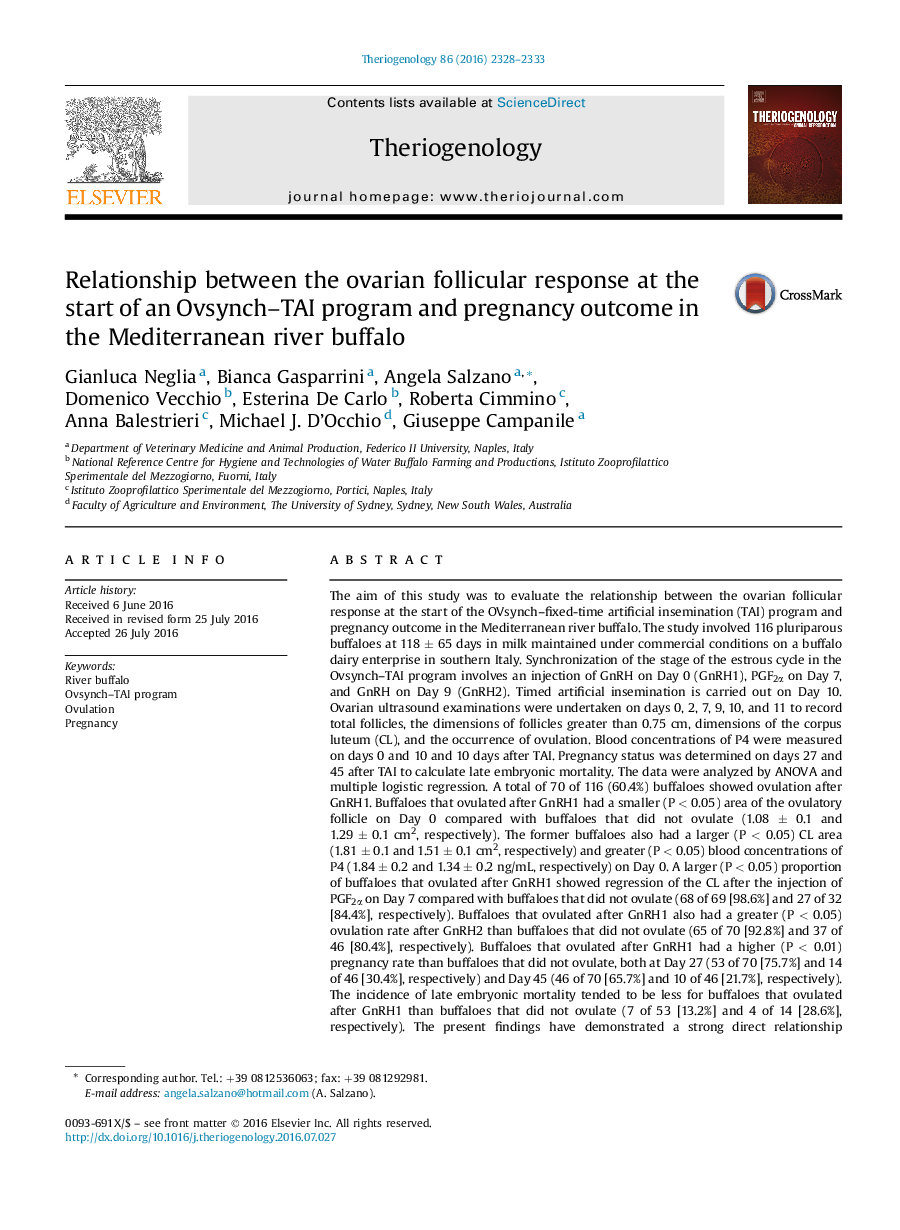| کد مقاله | کد نشریه | سال انتشار | مقاله انگلیسی | نسخه تمام متن |
|---|---|---|---|---|
| 5523547 | 1401377 | 2016 | 6 صفحه PDF | دانلود رایگان |

The aim of this study was to evaluate the relationship between the ovarian follicular response at the start of the OVsynch-fixed-time artificial insemination (TAI) program and pregnancy outcome in the Mediterranean river buffalo. The study involved 116 pluriparous buffaloes at 118 ± 65 days in milk maintained under commercial conditions on a buffalo dairy enterprise in southern Italy. Synchronization of the stage of the estrous cycle in the Ovsynch-TAI program involves an injection of GnRH on Day 0 (GnRH1), PGF2α on Day 7, and GnRH on Day 9 (GnRH2). Timed artificial insemination is carried out on Day 10. Ovarian ultrasound examinations were undertaken on days 0, 2, 7, 9, 10, and 11 to record total follicles, the dimensions of follicles greater than 0.75 cm, dimensions of the corpus luteum (CL), and the occurrence of ovulation. Blood concentrations of P4 were measured on days 0 and 10 and 10 days after TAI. Pregnancy status was determined on days 27 and 45 after TAI to calculate late embryonic mortality. The data were analyzed by ANOVA and multiple logistic regression. A total of 70 of 116 (60.4%) buffaloes showed ovulation after GnRH1. Buffaloes that ovulated after GnRH1 had a smaller (P < 0.05) area of the ovulatory follicle on Day 0 compared with buffaloes that did not ovulate (1.08 ± 0.1 and 1.29 ± 0.1 cm2, respectively). The former buffaloes also had a larger (P < 0.05) CL area (1.81 ± 0.1 and 1.51 ± 0.1 cm2, respectively) and greater (P < 0.05) blood concentrations of P4 (1.84 ± 0.2 and 1.34 ± 0.2 ng/mL, respectively) on Day 0. A larger (P < 0.05) proportion of buffaloes that ovulated after GnRH1 showed regression of the CL after the injection of PGF2α on Day 7 compared with buffaloes that did not ovulate (68 of 69 [98.6%] and 27 of 32 [84.4%], respectively). Buffaloes that ovulated after GnRH1 also had a greater (P < 0.05) ovulation rate after GnRH2 than buffaloes that did not ovulate (65 of 70 [92.8%] and 37 of 46 [80.4%], respectively). Buffaloes that ovulated after GnRH1 had a higher (P < 0.01) pregnancy rate than buffaloes that did not ovulate, both at Day 27 (53 of 70 [75.7%] and 14 of 46 [30.4%], respectively) and Day 45 (46 of 70 [65.7%] and 10 of 46 [21.7%], respectively). The incidence of late embryonic mortality tended to be less for buffaloes that ovulated after GnRH1 than buffaloes that did not ovulate (7 of 53 [13.2%] and 4 of 14 [28.6%], respectively). The present findings have demonstrated a strong direct relationship between the ovarian follicular response at the start of an OVsynch-TAI program and pregnancy outcome in the Mediterranean river buffalo.
Journal: Theriogenology - Volume 86, Issue 9, December 2016, Pages 2328-2333